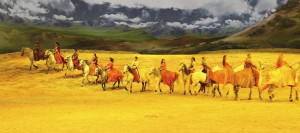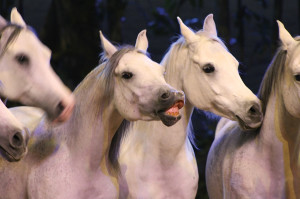Behind the Scenes at Cavalia’s Odysseo
Click here to read the complete article
A Transformative equine experience
By Brittany Bevis
 Through a seamless blending of equestrian arts, theatrical splendor, and technological ingenuity, Cavalia’s Odysseo creates a transformative experience that takes the audience on a journey through the arid desert of the African Savannah, beneath the swirling illumination of the Northern Lights, and across the panoramic vistas of Easter Island.
Through a seamless blending of equestrian arts, theatrical splendor, and technological ingenuity, Cavalia’s Odysseo creates a transformative experience that takes the audience on a journey through the arid desert of the African Savannah, beneath the swirling illumination of the Northern Lights, and across the panoramic vistas of Easter Island.
For two-and-a-half hours under the magical Big White Top in Frisco, Texas, the show lives up to its namesake, providing an escape from the mundane into a vibrant world where the partnership between man and equine is celebrated.
With Artistic Director Normand Latourelle at the helm since 2003, Cavalia has morphed into the largest touring show in the world, thrilling and captivating audiences in Canada, Mexico, and now the United States.
From the moment you spot the 125-foot tall tent of the Big White Top peeking out of the cityscape you know you’re in store for a truly magical experience. With capacity for 2,000 spectators, Odysseo’s main tent spans the length of two NFL football fields.
If the size and scope weren’t impressive enough, the 17,500 square foot main stage includes a hill, sculpted from 10,000 tons of rock and sand, that reaches nearly three stories high. It’s against this spectacular backdrop that the show’s 63 horses and 47 acrobats, aerialists, dancers, and musicians come together to elicit gasps and applause by performing at Liberty, in Trick Riding, Dressage, Cossack Riding, on an equestrian carousel that descends from the ceiling, and in a spectacular water-filled finale.
Uriel Chartrand-Ardail is a performer who has been with the show for three-and-a-half years. He first started out as an acrobat.
“What you see me perform with are the Chinese Poles and stilts,” he says. “I also do horseback riding in the finale and Cossack Riding, which is pretty much the same thing as Trick Riding, except it’s in a circle. It’s actually a different discipline. That’s when I focus on using my advantage as an acrobat.”
Chartrand-Ardail also relies on basic horse sense to deal with the challenges that can arise when performing with live animals.
“A lot of the challenges have to do with the environment, because horses are extremely sensitive animals,” he says. “When you think about how small something could be [that might scare them], something like the lighting or the sand or the huge trees we have mid-stage, we have to look out for those things and try to work around them.”
Helping to guide the horses and riders through their fully choreographed dance is Resident Director Darren Charles. With background as both a professional dancer and equestrian, Charles has the ability to oversee the riders, making sure they have correct posture, and was instrumental in developing some of the equine choreography. One of the more challenging parts of choreographing the show was introducing Cavalia’s resident troupe of African acrobats to an unfamiliar animal.
“They’d never really seen a horse before, so for them to be introduced to horses was a bit scary,” he says. “When combining choreography with horses and timing and everything, we need to have a lot of leeway. Sometimes, the horses will have minds of their own. With continual training, we got to a point where we were able to condense it all down. It’s an extravaganza!”
 One part of the show, when the audience grows very silent, is the Liberty act where six grey horses, Gus, Silver, Frosty, Nezma, Choice, and Octanium, join trainer Elise Verdoncq to perform a stunning routine that shows the incredible level of trust between horse and handler. With nearly imperceptible hand movements, Verdoncq guides the group of geldings to a peaceful tune that descends from the musician’s loft nestled atop trees located at the edge of the stage.
One part of the show, when the audience grows very silent, is the Liberty act where six grey horses, Gus, Silver, Frosty, Nezma, Choice, and Octanium, join trainer Elise Verdoncq to perform a stunning routine that shows the incredible level of trust between horse and handler. With nearly imperceptible hand movements, Verdoncq guides the group of geldings to a peaceful tune that descends from the musician’s loft nestled atop trees located at the edge of the stage.
“Liberty is one of the main scenes we rehearse every day, just to keep the horses motivated, because you need to have mutual respect,” Charles says. “As you see in the show, there is a lot of respect between the horse and the man, and that’s what we want to portray to the audience as well. It’s very important for us to portray that relationship, and, alongside choreography, that was one of the hardest things to do.”
Equestrian Director Dorian Escalon says the Liberty act is one of the most interesting portions of the show, even for those in the audience who might already be familiar with horses.
“It’s one of the most interesting, because every day you have to analyze your horses,” he says. “You have to find a way to be in his mind and try to understand what mood he is in every day. Even before the act, you have to observe them a lot. Does he want to play? Is he cranky? It depends, because every horse is totally different.”
With a number of performances lined up for the duration of the show, Escalon utilizes rotations to prevent the horses from burnout.
“That’s why we have so many horses,” he says. “We are always making rotations in our show; we don’t want it to be the same every night for the horses or for the riders. It’s important to keep the show alive and changing, and the horses are not working with their body and muscles in the same way every night.”
“We try to conserve our horses, the best we can. We want them to come on stage and enjoy this moment with us.”
While talented equines and equestrians are performing in the foreground, an enormous video backdrop, the size of three full IMAX screens, brings to life the deserts of Africa, an icy cavern dripping with crystals, a peaceful forest, and a biblical size wave. By far, one of the most impressive parts of the show takes place when the stage is flooded with 80,000 gallons of water so the horses and riders can perform a liquid ballet. Incredibly, when the show is over, it takes only 15 minutes for the entire lake to drain back into containers located underneath the audience, which allows stagehands to prepare for the next performance. With all of the high-flying stunts during the show, proper maintenance of both the lake and massive hill are crucial to ensure the safety and comfort of the animals and performers.
“Under the sand, there are all different levels that make the water pass back through,” he says. “There’s a lot of technology involved because [we can’t] let any sand or fiber go with the water. With horses, footing is the most important thing.”
“The hill is a really important thing too, because our hill is a true hill. Every day, we have to conserve it, and we try to make it the same in every city. The horses go up and down the hill, so it has to stay really compact under the feet of the horses to let them balance.”
Of the 63 equine performers to grace the stage there are 11 different breeds including Appaloosa, Arabian, Canadian, Holsteiner, Lusitano, Oldenburg, Paint Horse, Quarter Horse, Spanish Purebred, Warmblood, and Lipizzan hailing from Spain, Portugal, France, The Netherlands, Germany, United States, and Canada. For practical purposes, the show uses only geldings and stallions. The average age is 10, the youngest is four, and the oldest is 16.
For those interested in getting a backstage peek at the magic behind Odysseo, there is a limited number of backstage tours that include a Q&A session, an opportunity to visit the stage, explore the costume room, and take a tour of the Odysseo stable. Rendez-Vous VIP Premium Packages can include center row seats; a VIP pass to a complimentary buffet with wine, champagne, and beer; a dessert bar, coffee, and tea during intermission, and an exclusive stable tour.
For information about where Cavalia will be headed next, visit cavalia.net.










